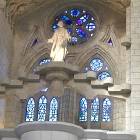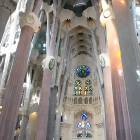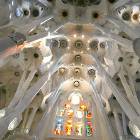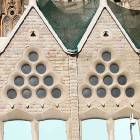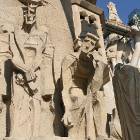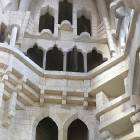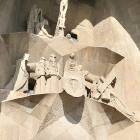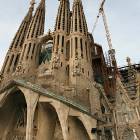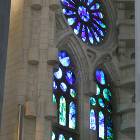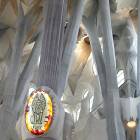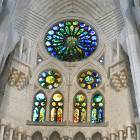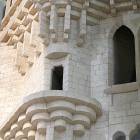Inside Sagrada Familia cathedral, the masterpiece of Antoni Gaudi
Our Saviour described the Kingdom of Heaven as something that can be taken by force. He made this intriguing remark when talking about the mission of John the Baptist, as the last of the prophets, and a bridge to the Christian age: until then, the Kingdom of Heaven belonged to those who obeyed the Law given through Moses, from now the Kingdom belonged to the striving ones, those who persevered in search of virtue, using sometimes surprising methods (Matthew 11,12). This idea of perseverance as a paradoxical way of actively seeking the divine Grace is also mentioned in the parable of the unjust judge, who decides to make justice to the widow just because of her insistence.
When entering Sagrada Familia in Barcelona you get the same feeling of witnessing the work of a tormented believer who strives in a siege for the Kingdom of Heaven, not with the established methods of religious architecture, but with the weapons of modern art. Brilliant decorations, ingenious abstract forms make up a continuous theme, that repeats and asserts itself like Ravel’s Bolero, until everything starts to vibrate. Here modern architecture is turned into a liturgy in stone, giving shape to the words inscribed on the outside spires: “Sanctus”, “Excelsior” and “Hosanna”.
The inside of this cathedral is as impressive as disappointing its outside is. The reason might be that the inside bears the imprint of Gaudi’s genius, while the outside is yet to comply with master’s vision, who wanted it vividly painted and, of course, still has some decades until being finished. There are three monumental entrances, each with a facade dedicated to a major allegorical theme: The Nativity, The Passion of Christ and the Glory of God, each corresponding to the three Christian virtues, named by Apostle Paul: Hope, Faith and Love. Only the Nativity facade is the work of Antoni Gaudi, the third being yet to be finished.
Inside the cathedral you witness the creativity of a genius competing with nature. High forests of white columns, that end with arches like palm leaves, cubist decorations around Art Nouveau colorful stained glass windows and marvelous spiraling staircases that seem to resemble a stairway to heaven. Long before the age of computers, Gaudi played with the possibilities of three-dimensional design, mixing hyperboloids with Gothic vaults and shapes that change from one row of columns to another. Most of the interior can be characterized as iconoclast, even the beautiful stained glass windows bearing abstract shapes, while the four evangelists are represented only by their symbols – the lion, the angel, the vulture and the bull. Some white statues on the walls blend in with the background and go unnoticed. All this refusal of imagery directs the view to the Christ on the cross that is hanging from the ceiling in front of the altar.
Sagrada Familia is the life work of Antoni Gaudi, one of the most creative architect in history, and a devout Christian. His austere life and the passion put into this cathedral made the later generations even propose his canonization by the Catholic Church. Gaudi was so absorbed by this project, that in the day of his tragic tramway accident, the locals mistook him as a beggar, due to his humble clothes. He had dedicated 42 years of this life to Sagrada Familia, and managed to complete less than a quarter of his imagined project. Even now, a century after his death in 1925, only 8 of the 18 spires are in place, and the largest of these towers is yet to be built. Everything is financed through donations, so with this being one of the most visited cathedrals in the world, chances are we will see it finished during our lifetime.
- Home Page
start page - Architecture
landmark buildings - Sacred architecture
places of worship - Nature
landscape photography - Concert
performing artists - Christmas
Santa Claus pictures
- Jooble
jobs for photographers - Escape
an out of control blog - Merry Christmas
The best organizer of Christmas parties - Astro photo
Eclipse hunting and astrological photography





